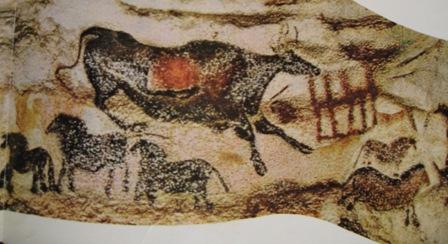Lascaux Cave (or Lascaux) is a complex of underground galleries famous for cave paintings, which were created in the period from the eighteenth to the fifteenth millennium BC. It was discovered by chance by four teenagers who came across a narrow passage, punched by a pine tree that fell from a lightning strike. The first to seriously study the art of the Upper Paleolithic in Lyasko was the expert on the history of the primitive society, Henri Braille. It was he who established the authenticity of the most ancient paintings.

Lascaux Cave is located in the south-west of France, near the village of Montignac, in the department of Dordogne. It is located in the valley of the Weser River, where at the beginning of the twentieth century other caves with rock paintings were discovered, mainly depicting large animals, such as Combarelle, Font de Gomme, and Bernafil. In such places, in which engraved and picturesque drawings are along walls and ceilings, primitive people most likely did not live. They were intended for ceremonial purposes.
Lascaux Cave is one of the most impressive examples of art created by a man of the Paleolithic era. It contains about 2000 images, which can be grouped into three main categories: animals, human figures (human images, as a rule, are very rare in Paleolithic art) and abstract symbols. Large-sized drawings are written using mineral pigments, and smaller images are carved in stone. Many images have been erased and are difficult to distinguish.
But in any case, this cave in France represents the first creative masterpiece of mankind, deserving the name of the
Sistine Chapel of primitive art. The most famous part of the cave is the “Bull Hall”, on the calcite walls of which are depicted bison, horses and deer (at a height of two meters from the ground level and on the natural cornice of the ceiling). Five black bison are the dominant figures among the accompanying horses and other animals. They are organized in two herds located opposite each other (two bison - on the north wall, three - on the south).
Each of the two sides is named in accordance with the animal represented on it. The wall on the north side is known as the “unicorn” panel because of the mysterious animal depicted here with a long and perfectly straight horn. On the south side is the “bear” panel. Here, the chest of one of the bison is partially covered by the picture of a small bear, in which ears and clawed legs are particularly prominent. One of the bison 5.2 meters high is the largest drawing representing cave painting.
Lascaux Cave was definitely a sacred space. Animals played an important role in the life of Paleolithic hunters. For a long time it was believed that such drawings were associated with primitive magic, due to which a spell of potential prey took place. In fact, of the animals depicted, only deer constituted the main diet of primitive people.
Painting in the Nave Gallery, called Crossed Bison, demonstrates the ability of Paleolithic ancestors to work with perspective. Of course, this is only its primitive form. The crossed legs of the bison create the illusion that one of the figures is closer to the viewer than the other.
Of course, Lyasko Cave has not yet revealed all its secrets, but its illustrated bestiary makes an indelible impression, it unites a modern person with its distant ancestors and helps to realize how the human essence began to build.